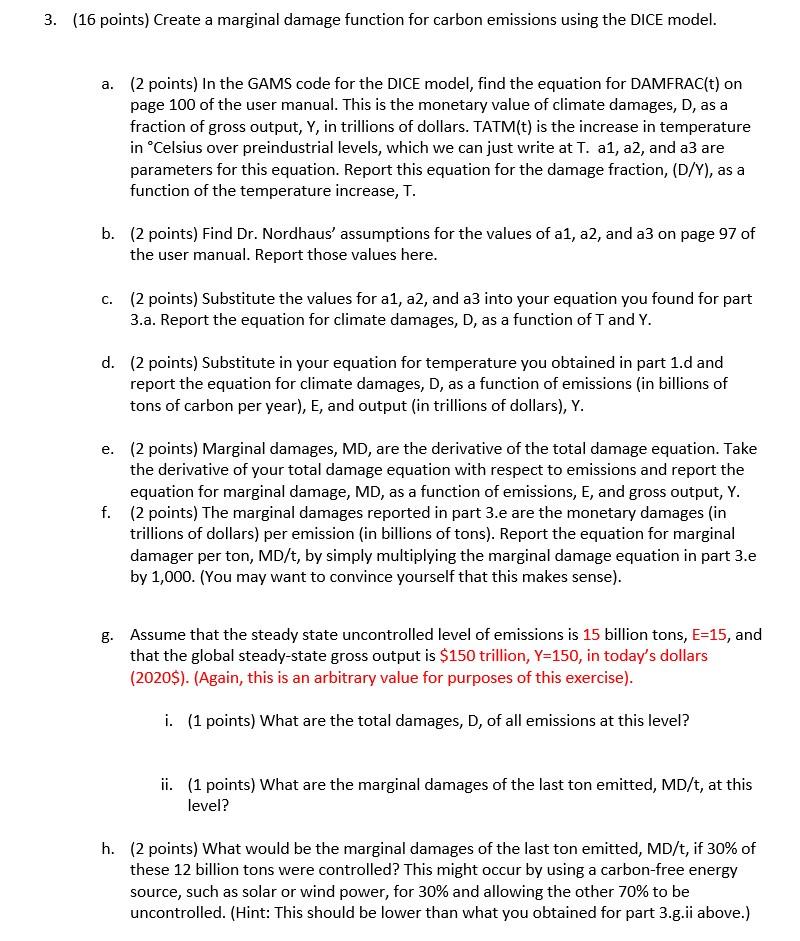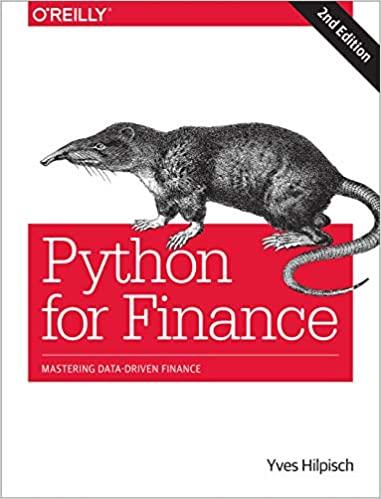Need Assistance with this exercise, need some guidance with setting up a marginal damaged function. I am not providing any third party source. The Dice Manual is public and can be easily access online if you google it, it's just for reference.

3. (16 points) Create a marginal damage function for carbon emissions using the DICE model. a. (2 points) In the GAMS code for the DICE model, find the equation for DAMFRAC(t) on page 100 of the user manual. This is the monetary value of climate damages, D, as a fraction of gross output, Y, in trillions of dollars. TATM(t) is the increase in temperature in Celsius over preindustrial levels, which we can just write at T. a1, a2, and a3 are parameters for this equation. Report this equation for the damage fraction, (D/Y), as a function of the temperature increase, T. b. (2 points) Find Dr. Nordhaus' assumptions for the values of a1, a2, and a3 on page 97 of the user manual. Report those values here. C. (2 points) Substitute the values for a1, a2, and a3 into your equation you found for part 3.a. Report the equation for climate damages, D, as a function of T and Y. d. (2 points) Substitute in your equation for temperature you obtained in part 1.d and report the equation for climate damages, D, as a function of emissions (in billions of tons of carbon per year), E, and output (in trillions of dollars), Y. e. (2 points) Marginal damages, MD, are the derivative of the total damage equation. Take the derivative of your total damage equation with respect to emissions and report the equation for marginal damage, MD, as a function of emissions, E, and gross output, Y. f. (2 points) The marginal damages reported in part 3.e are the monetary damages (in trillions of dollars) per emission (in billions of tons). Report the equation for marginal damager per ton, MD/t, by simply multiplying the marginal damage equation in part 3.e by 1,000. (You may want to convince yourself that this makes sense). 8. Assume that the steady state uncontrolled level of emissions is 15 billion tons, E=15, and that the global steady-state gross output is $150 trillion, Y=150, in today's dollars (2020$). (Again, this is an arbitrary value for purposes of this exercise). i. (1 points) What are the total damages, D, of all emissions at this level? ii. (1 points) What are the marginal damages of the last ton emitted, MD/t, at this level? h. (2 points) What would be the marginal damages of the last ton emitted, MD/t, if 30% of these 12 billion tons were controlled? This might occur by using a carbon-free energy source, such as solar or wind power, for 30% and allowing the other 70% to be uncontrolled. (Hint: This should be lower than what you obtained for part 3.g.ii above.) 3. (16 points) Create a marginal damage function for carbon emissions using the DICE model. a. (2 points) In the GAMS code for the DICE model, find the equation for DAMFRAC(t) on page 100 of the user manual. This is the monetary value of climate damages, D, as a fraction of gross output, Y, in trillions of dollars. TATM(t) is the increase in temperature in Celsius over preindustrial levels, which we can just write at T. a1, a2, and a3 are parameters for this equation. Report this equation for the damage fraction, (D/Y), as a function of the temperature increase, T. b. (2 points) Find Dr. Nordhaus' assumptions for the values of a1, a2, and a3 on page 97 of the user manual. Report those values here. C. (2 points) Substitute the values for a1, a2, and a3 into your equation you found for part 3.a. Report the equation for climate damages, D, as a function of T and Y. d. (2 points) Substitute in your equation for temperature you obtained in part 1.d and report the equation for climate damages, D, as a function of emissions (in billions of tons of carbon per year), E, and output (in trillions of dollars), Y. e. (2 points) Marginal damages, MD, are the derivative of the total damage equation. Take the derivative of your total damage equation with respect to emissions and report the equation for marginal damage, MD, as a function of emissions, E, and gross output, Y. f. (2 points) The marginal damages reported in part 3.e are the monetary damages (in trillions of dollars) per emission (in billions of tons). Report the equation for marginal damager per ton, MD/t, by simply multiplying the marginal damage equation in part 3.e by 1,000. (You may want to convince yourself that this makes sense). 8. Assume that the steady state uncontrolled level of emissions is 15 billion tons, E=15, and that the global steady-state gross output is $150 trillion, Y=150, in today's dollars (2020$). (Again, this is an arbitrary value for purposes of this exercise). i. (1 points) What are the total damages, D, of all emissions at this level? ii. (1 points) What are the marginal damages of the last ton emitted, MD/t, at this level? h. (2 points) What would be the marginal damages of the last ton emitted, MD/t, if 30% of these 12 billion tons were controlled? This might occur by using a carbon-free energy source, such as solar or wind power, for 30% and allowing the other 70% to be uncontrolled. (Hint: This should be lower than what you obtained for part 3.g.ii above.)







